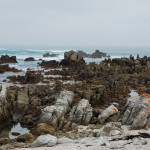CAPE OF NEEDLES (SOUTH AFRICAN REPUBLIC)
In April of this year, as we travelled in South African Republic, we did not miss the opportunity to visit Cape of Needles, even more so, since it was just ninety kilometers off the route of our journey.
Cape of Needles, which is also called Agulhas, is the southernmost tip of Africa and it is located on the territory of South African Republic.
The cape rises over the sea level by 140 meters and it is situated 155 kilometers southeast of the Cape of Good Hope. Cape of Needles is the tip of a spit stretching from the Cape land and ending with a lighthouse.
European seamen of XV century were afraid to travel to the west crossing the Atlantic, since they supposed that they would not be able to come back to Europe because of the predominant east wind. One mast ships of that time were able to make voyages to the west with the etesian winds but they were not very successful in sailing into the wind. The existence of Gulf Stream had not been discovered yet. Portugal, being the reigning sea power of that epoch, focused all of its resources on sea voyages to wealthy men of the East along the shores of Africa. And although Portuguese seamen were not sure that Indian and Atlantic oceans join, nevertheless, they travelled along African shores hoping to find a way to India. Finally, after the attempts that took almost seventy years Bartolomeu Dias sailed around the Cape of Good Hope in 1488. As he encountered on his way a few strong storms at the southern spur, Dias called the African headland the Cape of Storms but Portuguese authorities renamed it into the Cape of Good Hope.
Although no record of the Agulhas current has been preserved after the first trip, during the voyage of Vasco da Gamma in 1497, when he sailed around the Cape of Good Hope in the ships’ logbooks a southern current near Algoa Bay (close to the place, which is called Port Elizabeth today) is mentioned. This current was so strong that it delayed the fleet for three days. By the middle of XVI century, the Portuguese already knew a big deal about the Agulhas current and stayed in the open sea as they sailed around the African cape in the direction of India, but on the way home they stayed closer to the shore trying not to get too close to it.
As for the name of the Agulhas current, it comes from the name of the cape’s point – Cabo das Agulhas (Cape of Needles) thought up by the Portuguese seamen. There are two versions explaining why this name has been chosen. According to the first one, sharp cliffs and coastal riffs that destroyed many ships were often described as “needles”. Portuguese sailors called this cape “ship cemetery”. According to the other one, the name was given due to one discovery: on the tip of the cape the compass needle points exactly to the north and there is no discrepancy between the geographic and magnetic courses.

